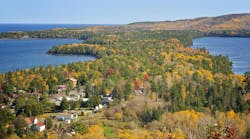Life Is a Beach
Over the past several years, Baby Beach has been closed more than it’s been open. Tucked in the back of Dana Point Harbor in Dana Point, Calif., the 200-yd stretch of sand ranks among the state’s most bacterially polluted ocean beaches. “No one is sure why the bacteria thrive there,” said Jim Volz, senior civil engineer of Orange County’s Watershed and Coastal Resources Division.
The challenge
Headlands Reserve LLC—a corporation wanting to build a resort and custom residential housing development at Dana Point—worked closely with the city and county to manage its runoff well.
Now called the Strand at Headlands, the 121-acre property rests about a quarter mile from the beach. Sixty-eight acres of open space will hold a wildlife conservation park, four other parks and walking trails. A key feature of the development is its best management practice (BMP) water quality treatment system, which helps mitigate the existing conditions at Baby Beach and insures that no water quality issues impact the beach.
“While no treatment train for storm water runoff addresses bacteria, managing the runoff has an impact on the beach,” said Taylor Darnall, the site’s property manager. “We wanted to work with Orange County to provide the best solution to address the problem from the start.”
The solution
Under different conditions, a sand filter could work. But there were concerns about disturbing the landscape to create one, the area it would occupy and its ease of maintenance. Instead, Headlands Reserve chose the StormScreen and Stormwater Management StormFilter from Contech Construction Solutions Inc. to manage and treat runoff and storm flows.
Installation took four days—three days to prepare the holes and one day to set the vaults in place. “Our biggest challenge was pumping out the groundwater from the ocean,” said Mike Trumble, president of Kennedy Pipeline. “At high tide there was about four feet of water in the holes.”
Installing the systems under a parking lot left more land available for other uses, such as parks and housing.
To install the system, workers dug a hole in the parking lot and removed a small section of storm drain installed in 1969. They constructed a manhole containing an 18-in.-high concrete diversion dam in a gap of the storm drain. When runoff exceeds the first-flush storm flow, it runs up and over this concrete dam and into the existing storm drain to the beach. The fixed concrete dam directs all urban runoff and first-flush storm flows out of the storm drain and into a 6-ft-by-12-ft StormScreen vault.
A 4-in.-diameter PVC pipe downstream of the StormScreen vault delivers urban runoff to the sanitary sewer. The valve between the StormScreen vault and the sanitary sewer is opened and closed at least twice a year. During the dry season, a county worker opens the valve so the urban runoff, after the StormScreen cleans it of debris, flows into the sanitary sewer. In the rainy season, the valve is closed so the outflow runs from the StormScreen into the StormFilter vault.
With an average rainfall of just over 12 in. a year, it’s rare to close the valve during the dry season, unless rain is forecast. When rain is expected, the county closes the valve to filter the storm water flow and capture as much particulate matter as possible in the StormFilter before emptying at the beach. “A recent dry season flow test showed about 300 gal of runoff a day,” said Volz. “We don’t expect the Headlands development to add much to that.”
The StormScreen captures any debris pea-sized (2.4 mm) or bigger from the flow before it enters the sanitary sewer during the dry season. It is a passive siphon-activated cartridge, and it assures the entire surface area of the screen is used evenly during every storm. Directing the dry season nuisance flows into the sanitary sewer prevents any bacteria in the flow from making it to the beach.
Downstream from the StormScreen are two large precast-concrete StormFilter vaults containing 154 filter cartridges for filtering storm water runoff during rain storms. Each filter cartridge contains three kinds of media: perlite, zeolite and activated carbon. These media target a full range of pollutants carried by runoff, such as total suspended solids (TSS), soluble heavy metals, oil and grease and nutrients. A 24-in. diameter, reinforced concrete pipe joins the StormFilter to an existing storm drain that empties runoff onto the beach at low tide and into the sea at high tide.
The results
“Headlands Reserve completed the design, installation and provided water quality improvements more quickly than Orange County could have,” said Volz.
According to Darnall, it is unusual to put the storm water treatment system in before the development, but that’s what Headlands Reserve did to make sure it did everything to help address the existing pollution and lessen the project’s impact on Baby Beach. Grading for custom home sites and the infrastructure has begun, and lot sales will begin in September. During this work, the company is using temporary measures such as sandbags, detention basins and matting for runoff control. An additional storm water management system for the residential phase of the development will be installed. The homeowners and the city will be responsible for the long-term maintenance.


